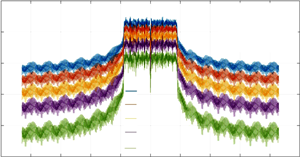Enhancing peak power efficiency of NOMA waveform for 5G and beyond 5G using SLM algorithm
DOI:
https://doi.org/10.3103/S0735272723050035Keywords:
5G, SLM, NOMA, PAPR, BERAbstract
The paper presents a novel approach for mitigating the detrimental effects of the high Peak-to-Average Power Ratio (PAPR) inherent in Non-Orthogonal Multiple Access (NOMA) waveforms using the Selective Mapping (SLM) technique. NOMA, a prominent multiple access scheme in modern wireless communication systems, facilitates concurrent transmission of multiple users over the same time-frequency resource. However, NOMA is susceptible to elevated PAPR, causing efficiency degradation and inter-symbol interference. The proposed method leverages SLM to address the PAPR challenges in NOMA waveforms. By generating a set of diverse phase sequences, SLM constructs alternative versions of the original NOMA signal. The phase sequence resulting in the lowest PAPR is then selected for transmission. This dynamic adaptation significantly reduces peaks in the transmitted signal, thereby enhancing efficiency, minimizing distortion, and reducing the risk of nonlinear amplification. Extensive simulations are conducted to evaluate the efficiency of the projected procedure. The results demonstrate remarkable PAPR reduction in NOMA waveforms compared to conventional transmission methods. Additionally, the method maintains signal quality, improving the Bit Error Rate (BER), power spectral density (PSD) and enhancing the overall reliability of the radio framework. The paper concludes with insights into the feasibility of integrating SLM into existing NOMA-enabled systems, offering a promising avenue for optimizing the efficacy of advanced radio networks.
References
- M. Hosseinzadeh Aghdam, A. A. Sharifi, “PAPR reduction in OFDM systems: An efficient PTS approach based on particle swarm optimization,” ICT Express, vol. 5, no. 3, pp. 178–181, 2019, doi: https://doi.org/10.1016/j.icte.2018.10.003.
- A. Kumar, N. Gour, H. Sharma, R. Pareek, “A hybrid technique for the PAPR reduction of NOMA waveform,” Int. J. Commun. Syst., vol. 36, no. 4, 2023, doi: https://doi.org/10.1002/dac.5412.
- A. Kumar et al., “Reducing PAPR with low complexity filtered NOMA using novel algorithm,” Sustainability, vol. 14, no. 15, p. 9631, 2022, doi: https://doi.org/10.3390/su14159631.
- A. Sahu, T. B. Rehman, K. Pachori, “Hybrid PAPR reduction techniques for 5G system: A survey,” in 2022 IEEE International Conference on Current Development in Engineering and Technology (CCET), 2022, pp. 1–7, doi: https://doi.org/10.1109/CCET56606.2022.10080781.
- T. Zhang, Z. Tong, W. Zhang, H. Wang, P. Li, “A novel PAPR reduction scheme based on joint traditional algorithm and machine learning for CO-OFDM systems,” IEEE Photonics Technol. Lett., vol. 35, no. 8, pp. 418–421, 2023, doi: https://doi.org/10.1109/LPT.2022.3233076.
- Z. Liu, X. Hu, W. Wang, F. M. Ghannouchi, “A joint PAPR reduction and digital predistortion based on real-valued neural networks for OFDM systems,” IEEE Trans. Broadcast., vol. 68, no. 1, pp. 223–231, 2022, doi: https://doi.org/10.1109/TBC.2021.3132158.
- D. Kong, X. Zheng, Y. Yang, Y. Zhang, T. Jiang, “A novel DFT-based scheme for PAPR reduction in FBMC/OQAM systems,” IEEE Wirel. Commun. Lett., vol. 10, no. 1, pp. 161–165, 2021, doi: https://doi.org/10.1109/LWC.2020.3024179.
- X. Wang, N. Jin, J. Wei, “A model-driven DL algorithm for PAPR reduction in OFDM system,” IEEE Commun. Lett., vol. 25, no. 7, pp. 2270–2274, 2021, doi: https://doi.org/10.1109/LCOMM.2021.3076605.
- S. Prasad, R. Jayabalan, “PAPR reduction in OFDM systems using modified SLM with different phase sequences,” Wirel. Pers. Commun., vol. 110, no. 2, pp. 913–929, 2020, doi: https://doi.org/10.1007/s11277-019-06763-7.
- A. Kumar, “PAPR reduction of FBMC using hybrid and k-hybrid techniques,” Radioelectron. Commun. Syst., vol. 62, no. 10, pp. 501–509, 2019, doi: https://doi.org/10.3103/S0735272719100029.
- S. Selvin Pradeep Kumar, C. Agees Kumar, R. Jemila Rose, “An efficient SLM technique based on chaotic biogeography-based optimization algorithm for PAPR reduction in GFDM waveform,” Automatika, vol. 64, no. 1, pp. 93–103, 2023, doi: https://doi.org/10.1080/00051144.2022.2106532.
- M. Mounir, M. I. Youssef, A. M. Aboshosha, “Low-complexity selective mapping technique for PAPR reduction in downlink power domain OFDM-NOMA,” EURASIP J. Adv. Signal Process., vol. 2023, no. 1, p. 10, 2023, doi: https://doi.org/10.1186/s13634-022-00968-y.
- X. Cheng, S. He, K. Qian, X. Wang, “A novel discrete ABC algorithm-based SLM scheme for PAPR reduction in OFDM systems,” in 2022 7th International Conference on Computational Intelligence and Applications (ICCIA), 2022, pp. 200–204, doi: https://doi.org/10.1109/ICCIA55271.2022.9828414.
- A. Kumar, H. Rathore, “Modified DSLM technique for PAPR reduction in FBMC system,” Radioelectron. Commun. Syst., vol. 62, no. 8, pp. 416–421, 2019, doi: https://doi.org/10.3103/S0735272719080053.


